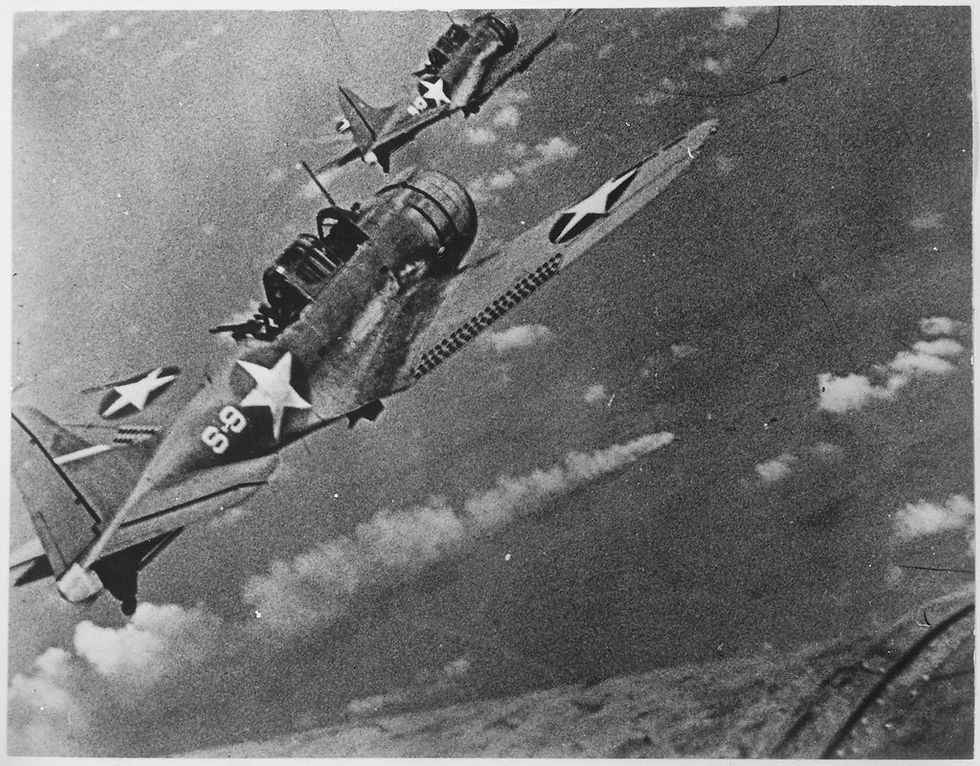Midway, Alternate History, and the Matter of Interpretation
- Sea Lion Press
- Jun 10, 2022
- 3 min read
By Matthew Kresal

Eighty years ago this week, one of the defining battles of the Second World War's Pacific theatre took place. The Battle of Midway, which occurred over two days in the seas around the eponymous atoll, saw the Imperial Japanese Navy's advances across the Pacific blunted. Losing four aircraft carriers, a heavy cruiser, 238 aircraft, and over three thousand sailors during those days in early June 1942 represented an utter rout for a force that had crippled the opposing US Navy at Pearl Harbor just six months earlier.
As someone with an (obvious) interest in alternate history, I've asked the obvious question at times: Did it have to be that way?
In 2020, when I read the 2001 anthology Rising Sun Victorious (which I later reviewed on this blog last spring), I encountered two essays proposing alternative outcomes to the battle. The first, James Arnold's “Coral And Purple: The Lost Advantage,” turned on circumstances allowing the Japanese to realize that American cryptographers had cracked the JN-25b code, thus allowing the setting of a trap at Midway. The second, Forrest R. Lindsey's “Nagumo's Luck,” turns on naval aviator Wade McCluskey deciding to turn his flight of Dauntless dive-bombers in a direction he did in real-life. The dive-bombers having thus failed to take out three of the Japanese carriers in an incredible seven minutes and set the stage for an eventual (and unsuccessful) Japanese attack on California and the Panama Canal.
Both those essays, like the anthology itself, were written circa 2001. In envisioning alternate outcomes, writers of alternate history rely on the work of those who have studied the battle as it unfolded. Decades' worth of historians have analyzed the events at Midway in numerous books and articles, from academic texts to works of popular history. Works that have, in due course, influenced popular perceptions of the battle in films such as the 1976 and 2019 films both named Midway and, likewise, alternate history scenarios such as the two discussed above.
In the article “Timeless Battle, Evolving Interpretations” found in the current issue of Naval History, the historian Jonathan Parshall (co-author of the 2005 book Shattered Sword on the battle) notes how views of the battle have changed. In the immediate aftermath of the battle and into the immediate post-war period, Army Air Force B-17 bombers launched from the island claimed to have damaged at least one Japanese carrier, making their way into non-fiction and propaganda alike such as the 1943 film Air Force. The "fact" stood until 1948, when, six years after the battle, the post-war study of photographs and the translation of Admiral Nagumo's after-action report revealed its falsehood. Similarly, the submarine USS Nautilus was credited with sinking the carrier Soryu with multiple torpedoes until the late 1960s. Only then did Walter Lord's research for his book Incredible Victory settle the matter: The Nautilus had not only fired upon an entirely different carrier, but its single hit had, in keeping with a common issue during the war's first year, been a dud torpedo.
Indeed, one aspect of Midway, the interpretation of its being an American victory against overwhelming odds through codebreaking and pilot's audacity, which underlies both essays earlier cited, had been called into question. As Parshall and Anthony Tully noted in Shattered Sword, and Parshall has done so again in his recent article, the forces facing off against each other at the battle's opening were comparable. The Japanese had four carriers and 264 aircraft against three US carriers and 306 aircraft, including those based at Midway's airfield. As Parshall wryly noted in Naval History, "David vs. Goliath this was not — and the reason it was not was because of poor Japanese planning and their unwillingness to muster all available force at the point of contact." Midway being, perhaps, as much Japan's battle to lose as America's to win.
None of these conclusions, and others detailed elsewhere, necessarily derail the alternate history works cited earlier in this blog. Instead, they raise another point: historical interpretation affects dramatic presentations and re-imaginings. The Battle of Midway and how it unfolded is but a single example, as are those essays. Their visions of alternate outcomes to a pivot point of the Pacific War tell us as much about historical orthodoxy at their writing as bout the battle itself and how different history might have gone.
It also highlights an underlying truth. The novelist and filmmaker Nicholas Meyer has observed that "All art is the product of the time it was made in." Alternate history is no exception, based on the research and interpretation of the past to craft stories to be read in the present and future. And every bit as subject to the winds of change or the interpretations of historians.
Matthew Kresal is a fiction writer who has a (Sidewise Winning) story in the Alternate Australias Anthology by Sea Lion Press, and has also written a Sea Lion Press novel about Joe McCarthy.

Comentarios